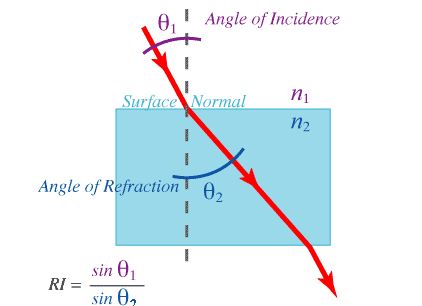Measuring Sugar Content of a Liquid
with a Laser
Pointer
Abstract
We will be using
a laser pointer pen and some knowledge of physics to determine the
concentration of sugar dissolved in a liquid.
Objective
The objective of
this experiment is to see if sugar concentrations in water can be determined
using the index of refraction of the solution.
No doubt you have noticed the odd "bending" effect that
you see when you put a straw (or pencil) in a glass of water. The water
refracts the light, so the straw appears to bend at an angle when you look at
the interface between the air and the water.
Compare the two images below and see if you notice anything different between them.
These two images illustrate
refraction by liquids. Which glass contains plain water, and which glass
contains sugar-water?
Snell's
Law describes the physics of refraction (see below).
Watch a video to learn all about light and how it refracts:
Watch a video to learn all about light and how it refracts:
If we
follow a light ray (red) as it passes from air to water, we can see how the
light bends.
Air and water each have a different index of refraction (symbolized
by the variable n).
Snell's
Law describes the angle of refraction of a light ray in terms of the angle of
incidence and the index of refraction of each of the materials through which
the light is passing (air and water in this case).
In
optics, angles are measured from a line perpendicular to the surface with which
the light is interacting. This line is called the surface normal, or simply, the normal (dashed gray line above).
The
angle of incidence, θ1,
and the angle of refraction, θ2,
are shown.
Snell's
Law says that the relative index of refraction of the two materials (RI = n2/n1)
is equal to the sine of the angle of incidence (sine θ1)
divided by the sine of the angle of refraction (sine θ2).
What Snell's Law tells us is that the greater the
relative index of refraction, the more the light bends.
The
index of refraction of a liquid depends on the density of the liquid. Dissolving sugar in water results in a
solution with density greater than that of water alone. Since sugar water is denser than plain water,
sugar water should have a higher index of refraction than plain water.
In the
two glasses above, one glass has plain water and the other glass has sugar
water.
Can you tell which is which?
You will learn how to use the physics of refraction to
measure the sugar content of a clear liquid solution (e.g., apple juice, or a
clear soda drink).
You'll use a laser pointer and a hollow glass prism (which you'll
be shown how to make).
Below you see a diagram of the setup.
Diagram of setup for measuring the index of refraction of a liquid
using a laser pointer and a hollow triangular prism (not to scale).
When
there is no liquid in the prism, the laser light (dotted red line) will shine straight
through to a wall (solid black line).
When the prism is filled with liquid, the
laser light will be refracted (solid blue and red lines).
The angle of
deviation will be at a minimum when the light passing through the prism (solid
blue line) is parallel to the base of the prism.
You'll
have to rotate the prism just right so that this is true.
Then you'll measure
two distances, x and L, and use them to calculate the angle of minimum
deviation.
From this angle, you can calculate the index of refraction.
Equation 1 is the formula for doing this.
Equation 1 looks complicated at first, but it's actually not so bad.
θmd is the angle of minimum deviation, which you will measure (you'll be shown how in the Experimental Procedure section).
θp is the apex angle of the prism. Since the prism is an equilateral triangle, the apex angle is 60°.
In equation 2, we've substituted 60° for θp.
In equation 3, we've substituted the numerical value of the index of refraction of air (nair = 1.00028).
The sine of 30° is 0.5, so we've made that substitution in equation 3.
Finally, we simplify the numerical terms to produce Equation 4, which is the one you will use.
Plug in your measured value for θmd, add 60°, and multiply the result by one-half.
Then take the sine of the result, and multiply by 2.00056, and you'll have the desired index of refraction.










